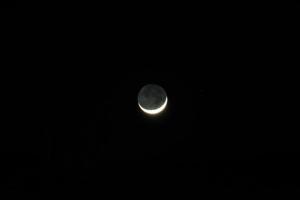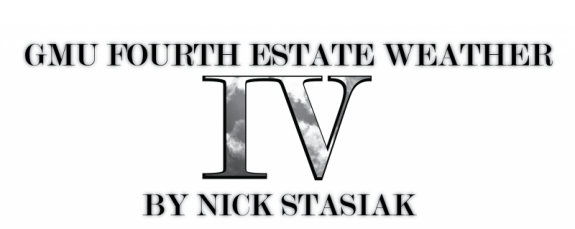Nick Stasiak
Conquer the sea
|
 |
| (Photo courtesy of Nick Stasiak) |
It’s finals week...which means no sleep, caffeine, and an endless array of essays and cram sessions. B
Solar Maximum 2013
|Most people think weather is just a term on Earth, but weather is everywhere. Weather even takes place outside of Earth, in space. A typical type of space weather involves solar flares. Did you know that on April 11, the most powerful solar flare of the year erupted from the sun? And did you also realize that there was a temporary radio blackout from it? Maybe you heard about the sudden Aurora Borealis of the east coast?
Fire weather invades the east
|
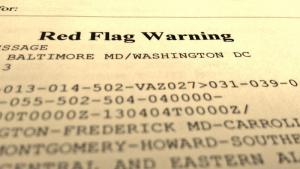 |
| (Photo courtesy of Nick Stasiak) |
It’s not very often that you see my weather report say, ‘Red Flag Warning.’ This past Tuesday, the National Weather Service issued a Fire Weather Watch. On Wednesday, Fairfax was upgraded to a ‘Red Flag Warning.’ Everyone from the west coast here at Mason knew just what this meant. The term was pretty odd to the rest of us though. So what exactly does a ‘Fire Weather’ or ‘Red Flag’ alert mean?
Record breaking snowstorm surprises mason
|
 |
| (Photo courtesy of Nick Stasiak) |
In my previous blog post, I mentioned the possibility of another snowstorm blowing through the area. I had never imagined we would get a record-breaking storm though. Indeed, the 3.5 inches of snow that George Mason University saw on Monday morning set a record in Fairfax and DC.
Monday morning, we all witnessed the latest snowstorm for the Metro area in 23 years. The last time DC saw over 3 inches of snow this late in the year was back on March 24, 1990. Not only did Monday’s storm break that record, but it ended the longest inch-free streak for DC ever recorded. The last time DC had a single inch of snow was on January 26, 2011. Who would have thought the largest snow accumulation recorded this year would be in the beginning of spring?
Happy Spring?
|
 |
| (Photo courtesy of Nick Stasiak) |
The vernal equinox, also known as the first day of spring, took place on March 20. This occurrence was strange to most people as the first day of spring is usually March 21. I won’t go too much in detail in regard to this change, but it seems as though the gravity pull from other planets in our solar system is affecting the Earth’s orbit and timing of spring. The Earth’s elliptical orbit is also changing its orientation relative to the sun. This is known as precession. By 2020, the entire United States could see spring start as early as March 19.
National Severe Weather Preparedness Week
|
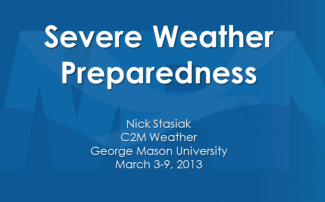 |
| (Photo courtesy of Nick Stasiak) |
This week is National Severe Weather Preparedness Week. From March 3-9, the nation is encouraged to learn more about how to stay prepared in case of severe weather this year. Storms are getting stronger and more lives are being threatened every year. Every day this week, C2M Weather will post random facts and tips about how to stay prepared in emergency weather. Pay close attention to these posts as they may very well come in handy.
Mason students attend 'Forward on Climate' Rally in D.C.
|
 |
| (Photo courtesy of Brittany Grutter) |
On Sunday, Feb. 17, people from all over the nation gathered on the National Mall to hold a climate change rally. This event was called, “Forward on Climate.” Battling through extremely low temperatures and freezing wind chills, over 30,000 people made sure President Obama heard their voices. Rest assured that a major statement was made on President’s Day: from marching up and down the National Mall to chanting for a fight against climate, the crowd made their presence and their cause known. Many students and staff members from our very own George Mason University were present on this historical day.
Asteroid 2012 DA14
||
|
| (Photo courtesy of Andrew Fitzpatrick) |
Hold on tight, George Mason University. On Feb. 15, the day after Valentine’s Day, asteroid 2012 DA14 will pass extremely close to Earth. With a size of about 150 feet (45 meters), this asteroid is relatively small. Traveling at a speed of 12,500 mph, asteroid 2012 DA14 is flying eight times faster than a rifle bullet.
If it were to crash in to Earth, it would be the equivalent of a 2.4 megaton bomb. The impact wouldn’t be a global catastrophe, but it would destroy a large area. Asteroid 2012 DA14 will come as close as 17,000 miles to Earth, which is really not that far away in space.
What's with the wacky weather?
|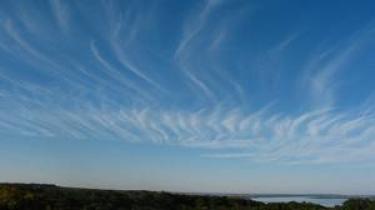 From temperatures below 20 degrees to highs in the 70s, this week’s weather has been nothing short of insane.
From temperatures below 20 degrees to highs in the 70s, this week’s weather has been nothing short of insane.

